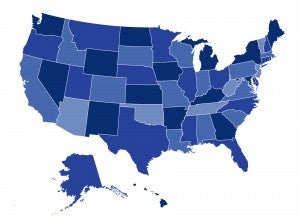
As we near the end of the second week of a so-far successful Open Enrollment, uncertainty over the future of the Affordable Care Act remains a challenge. As insurers and state regulators prepared for the 2018 plan year, they addressed questions of whether Congress or the Trump Administration would make major changes to the law. Some insurers exited or reduced service areas in the health insurance marketplaces, while others threatened exits or delayed participation decisions. In several states, some or all counties seemed likely to have no insurance plan available for residents seeking marketplace coverage. But once the dust settled and after much collaboration between state officials and insurers, no counties are without an insurer for plan year 2018.
In a recently published issue brief for the Robert Wood Johnson Foundation, CHIR experts examine the actions of six states that faced the prospect of bare counties for 2018: Iowa, Nevada, Ohio, Oklahoma, Tennessee, and Washington. Either the state had only one participating insurer, or the last remaining insurer in some counties announced a planned exit during the spring or summer of 2017. Interviews with insurers and state regulators provided insights into how they addressed the threat of bare counties.
We found that most insurers and state regulators agree on many aspects of the policy environment that affected the bare county situation:
- Uncertainty over federal policy, especially payments for cost-sharing reduction plans and enforcement of the individual mandate, is a primary contributor to decreased insurer participation in individual markets.
- Good longstanding relationships between regulators and the industry were an important foundation for negotiations over filling bare counties.
- Although an insurer’s decision ultimately needed to align with the company’s business strategy, state actions also helped prevent bare counties through assurance from state regulators of protection from financial losses resulting from unexpected policy change as well as other issues.
States also employed various regulatory levers to encourage insurer participation, such as clarifying regulatory standards regarding network adequacy, allowing flexibility in plan offerings, and sharing data on claims history. Some states also committed to future policies to stabilize the marketplace, including proposals for 1332 waivers (ultimately withdrawn in two of our study states). Another lever utilized by states was offering an advantage in Medicaid managed care contracts bidding to insurers that promises to participate in the state’s marketplace.
State regulators and insurers were unanimous in their belief that future stabilization of the individual market would require federal policymaking. State insurance regulators and insurers have stated that the brokered solutions that served this year’s marketplace are not likely to be lasting. Without greater certainty from the federal government, states will once again face the risk of bare counties—and consumers the loss of coverage—in 2019 and beyond.
You can learn more about how states and insurers successfully reached agreements to ensure all their residents could maintain access to ACA coverage, read and download the full brief here.

